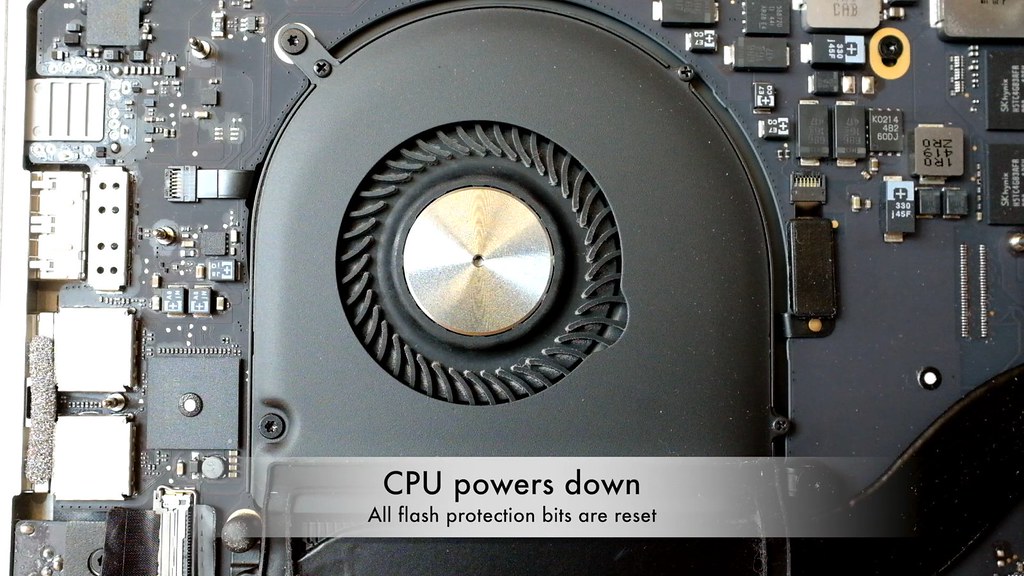Thunderstrike2 demo
This is an annotated transcript of the Thunderstrike 2 demo video since it is a lot of information packed into the two minute demo. There is also a Thunderstrike 2 overview and extensive details.
 Thunderstrike 2 starts with a local root priv exploit that can load a kernel module to give it access to raw memory.
Thunderstrike 2 starts with a local root priv exploit that can load a kernel module to give it access to raw memory.
 On some systems it can immediately unlock and re-write the motherboard boot flash, on others it needs to hook the s3 resume script and wait for a sleep event.
This builds upon the information we learned in the original Thunderstrike research, namely how to append PE files to the Firmware Volumes and how Apple verifies the integrity using CRC32.
On some systems it can immediately unlock and re-write the motherboard boot flash, on others it needs to hook the s3 resume script and wait for a sleep event.
This builds upon the information we learned in the original Thunderstrike research, namely how to append PE files to the Firmware Volumes and how Apple verifies the integrity using CRC32.
 It also can search for removable thunderbolt devices and write itself into their option ROMs.
It also can search for removable thunderbolt devices and write itself into their option ROMs.
 This is an improvement over thunderstrike 1 which required physical
access to attack a machine.
This is an improvement over thunderstrike 1 which required physical
access to attack a machine.
 Like the original, Thunderstrike 2's
proof of concept is not very stealthy, so when the system reboots,
the logo is displayed and various hooks are inserted into the running
EFI firmware.
Like the original, Thunderstrike 2's
proof of concept is not very stealthy, so when the system reboots,
the logo is displayed and various hooks are inserted into the running
EFI firmware.
 when the infected adapter is connected to a fresh laptop during a
system boot, the option rom is executed by efi firmware before the
kernel is started.
when the infected adapter is connected to a fresh laptop during a
system boot, the option rom is executed by efi firmware before the
kernel is started.
 The option rom can't directly write to the
flash, so instead it hooks the s3 resume script using the Darth Venamis
vunerability. This code will be executed
when the system comes out of a sleep mode. Addtionally if you look closely behind the title bar
in this image you can see the FileVault password that was keylogged.
The option rom can't directly write to the
flash, so instead it hooks the s3 resume script using the Darth Venamis
vunerability. This code will be executed
when the system comes out of a sleep mode. Addtionally if you look closely behind the title bar
in this image you can see the FileVault password that was keylogged.
 Later the system goes to sleep and the CPU enters a low-power state and
all of the flash lock bits are reset into their unlocked state.
We can identify when the system has entered the s3 suspend to ram
sleep, by waiting for the fans to shut down. When the system resumes
there is a window of time to write Thunderstrike 2 into the motherboard boot flash.
Later the system goes to sleep and the CPU enters a low-power state and
all of the flash lock bits are reset into their unlocked state.
We can identify when the system has entered the s3 suspend to ram
sleep, by waiting for the fans to shut down. When the system resumes
there is a window of time to write Thunderstrike 2 into the motherboard boot flash.
 Once installed in the boot flash, it is very difficult to remove
since it controls the system from the very first instruction exceuted
upon booting, including the keys for updating the firmware.
Reinstalling OS X won't remove it, replacing the harddrive won't
remove it. Even swapping to a new laptop has the possibility of
re-infecting from thunderbolt devices that might have been shared.
Once installed in the boot flash, it is very difficult to remove
since it controls the system from the very first instruction exceuted
upon booting, including the keys for updating the firmware.
Reinstalling OS X won't remove it, replacing the harddrive won't
remove it. Even swapping to a new laptop has the possibility of
re-infecting from thunderbolt devices that might have been shared.
Again, this poc isn't very stealthy, so when the system reboots we'll see the thunderstrike logo. A weaponized version could use virtualization or SMM to hide from attempts to detect it.
 Thunderstrike 2 also watches for new Thunderbolt devices
to be attached, and can write itself to a clean adapter when it
detects the PCIe hot plug event. This hardware transmission
vector allows it to potentially cross airgap security measures.
Thunderstrike 2 also watches for new Thunderbolt devices
to be attached, and can write itself to a clean adapter when it
detects the PCIe hot plug event. This hardware transmission
vector allows it to potentially cross airgap security measures.
 Thunderstrike 2's proof of concept demonstrates the entire cycle of
a software exploit that can write to the motherboard boot flash,
which can then infect Thunderbolt option ROMs, which can hook the
S3 resume script or SMM and repeat the installation into
motherboard boot flash chips on new machines.
Thunderstrike 2's proof of concept demonstrates the entire cycle of
a software exploit that can write to the motherboard boot flash,
which can then infect Thunderbolt option ROMs, which can hook the
S3 resume script or SMM and repeat the installation into
motherboard boot flash chips on new machines.
